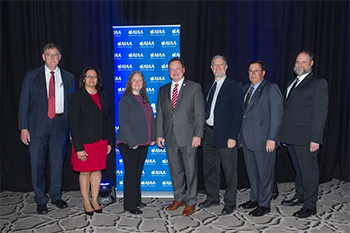Panelists: Moderator Joseph Morrison, associate project manager, Transformational Tools and Technologies, NASA’s Langley Research Center; Jandria Alexander, principal, Booz Allen Hamilton Inc.; David Keyes, director, Extreme Computing Research Center, King Abdullah University of Science & Technology; Pamela Kobryn, principal aerospace engineer, Structures Technology Branch, Aerospace Vehicles Division, Aerospace Systems Directorate, Air Force Research Laboratory; Dimitri Mavris, director, Aerospace Systems Design Laboratory, Georgia Institute of Technology; Mark Valentine, Department of Defense Strategic Initiatives Group, Microsoft
by Michele McDonald, AIAA Communications
An influx of data, driven in part by tiny sensors, is creating a big data transformation that promises to help the aerospace industry get ahead of problems before they happen, panelists discussed Jan. 9 during the “Data, Data Everywhere … the Devil in the Details” session at the 2018 AIAA SciTech Forum in Kissimmee, Florida.
Dimitri Mavris, director of the Aerospace Systems Design Laboratory at the Georgia Institute of Technology, said the area is so new that no one’s an expert.
“We’re going to make this journey together,” he said.
The panelists said the complex problems big data could help solve are spurring more questions, including how to deal with data reliability, threats, privacy and integration.
“The elephant in the room is obviously the protection of data,” said Pamela Kobryn, a principal aerospace engineer with the Aerospace Systems Directorate at the Air Force Research Laboratory. “How do we quantify uncertainty?”
Kobryn wondered on calibration and updating models as well as how to run them efficiently enough to have the data in the time frame needed. She said end users are part of the equation.
“Who’s going to be using the predictions, and what are they going to do with them, and what is the time frame?” Kobryn added.
Collecting personal data adds other layers of complexity, Kobryn said, explaining data will need to be managed, archived, stored and adapted over time.
The panelists said in the past decade, some crucial pieces have fallen into place to help big data move into the daily realm.
Mavris said it’s not just one, but many technologies and that a multidisciplinary approach needs to be taken. Key enabling technology includes surrogate modeling techniques, high performance computing, advanced data analytics and visualization, advanced sensing technology, and machine learning, he said.
“The sensing (technology) is actually leading this parade,” Mavris said.
The aerospace industry has the opportunity to dig deeper and apply big data-related technology to current problems, he said.
Digital twins, which mimic their physical counterparts and help predict outcomes, encounter widely varying degrees of complexity within the same industry, Kobryn said, adding the same general concept can be applied to commercial, general and military aviation but that the problems and complexities are vastly different within the areas.
For example, she said, commercial aircraft have fairly predictable variables, but the military operates from austere bases or aircraft carriers and often in harsh conditions. The average age of the U.S. Air Force fleet is pushing 30 years so, Kobryn said, predictive maintenance is essential.
And then there’s space.
“When you talk about space exploration, it’s a completely different story because you don’t have the chance to perform maintenance,” Kobryn continued. “You have one chance to execute the mission … the ideal scenario is to use digital twin technology to design in ultra-high reliability from the start, and while you’re on the mission, you want to be able to use the data you gather to adapt the mission to any risks you identify, and the digital twin would help you identify risks.”
The audience members seemed to think the industry is in the early stages of the big data revolution. They rated data technology as at the “peak of inflated expectations” of the Gartner Hype Cycle, according to an informal poll of those in the room. While some attendees think we’re in the “trough of disillusionment,” others think we’re moving toward the “slope enlightenment.”

